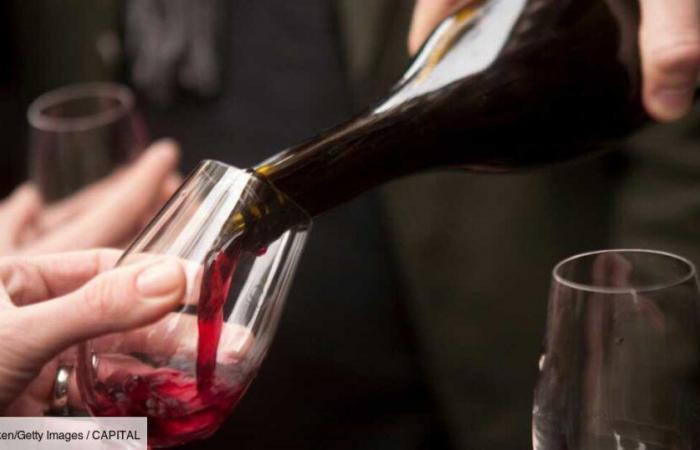«Beaujolais ? But you don't think about it, it's undrinkable…» Until recently, sommeliers who dared to propose the appellation were sharply rebuffed. Its reputation as an “industrial” wine, caused in particular by the hectoliters of Beaujolais Nouveau dumped all over the planet, had permanently tarnished the image of an entire vineyard. To the despair of local wine growers who had not given in to the productivist model. Alexandre Bonnouvriée, director of the Habile restaurant, a Parisian bistronomy restaurant, was obliged to offer the nectar he had in his cellar as a chardonnay, named after its grape variety.
In return for this, we snatched it away. And then the tide turned. Was it word of mouth, specialist magazines or even the agit-prop of this handful of fields struggling to attract attention? Still, at the start of the 2020s, sommeliers and wine merchants began ordering Brouillys, Morgons, Moulin-à-Vents and Beaujolais-Villages again.
Beaujolais Nouveau wants to win back consumers
A race for fatal productivity
The name has come a long way. Around thirty years ago, an entire wine model went out of control. To produce more and more cheap wines, and in particular to meet the demand of mass distribution, we have overdoped the vines with chemical fertilizers. “In my childhood I saw real walls of grapes», remembers Mathieu Lapierre, 42 years old, co-manager of Domaine Marcel Lapierre. The time was not very careful about respecting the yields authorized by the appellations of origin (a maximum of 56 hectoliters per hectare for the ten Beaujolais crus, such as Morgon, Fleurie or Juliénas, and 60 hectoliters for the simple Beaujolais): the oldest speak of 150 hectoliters per hectare, with part of the surplus then being sold undercover.
With so many clusters on each vine, the reds were very weakly condensed, even a little “floaty”. Furthermore, to reduce costs, weedkillers were preferred to plowing and, as pesticides were also used, the taste of the wines was increasingly altered. To complete the picture, sulphites were also abused, which stabilize wines but prevent them from releasing their aromas. This is how consumers have gradually turned away from these names.
A hyperproductive model of very cheap wines which therefore no longer allows winegrowers to make ends meet. As a result, a large number have retired without finding a successor. Since the year 2000, the vineyard has lost a third of its holdings, going from 2,500 to 1,700 estates. Other properties have reduced their size, halving the number of hectares over the same period.
The wine region only produced 587,000 hectoliters of wine, compared to 1.5 million in its best years. The worst is Beaujolais Nouveau, of which the world will only drink 16 million bottles in 2023, compared to 60 million in 2000. The Japanese, who fell head over heels for it, are buying six times less.
France becomes the leading wine producer
New winegrowers aim for quality
But the crisis would immediately trigger the rebirth of the region. If a hectare in the vintages can still be worth between 40,000 and 100,000 euros, that of Beaujolais-Villages has collapsed to 9,000 euros. Enough to attract young viticulture-oenology graduates and other agricultural engineers who, after having traveled the Old and New Worlds to learn their trade, return, often without much money, with the intention of settling down.
For them, of course, there is no question of conforming to a moribund model which still sees 80% of winegrowers bringing their wines, or even simply their grapes, to the 200 merchants and 9 cooperatives in the vineyard. As they know that we cannot live by selling their Beaujolais Nouveau to merchants for 3 euros per liter (the current price), they immediately choose to move upmarket, by giving up drugging the vines with synthetic fertilizers, by abandoning chemistry for the plow, sometimes pulled by a horse, or by favoring natural fermentation without using 71B yeast which is the origin of the banana taste.
Young “recruits” joining the ranks of quality pioneers. The Marcel Lapierre, succeeded by his children Mathieu and Camille, the Dominique Piron, Jean-Paul Thévenet, Jean Foillard, the Claude Vincent Geoffray (Château Thivin) or Louis Claude Desvignes, these few dozen descendants of generations of the land who have always refused, for thirty years, to switch to industrial wine.
They also often grow organically. “In Beaujolais, 120 winegrowers have made this choice, which represents 15% of the surface area.», welcomes Brieg Clodoré, a manager of Agribio Rhône & Loire. As for those who still use chemistry, they have greatly reduced the doses, says Mathieu Lapierre. This is confirmed by Philippe Bardet, who until a few months ago was the president of Inter Beaujolais: “We are reducing the frequency of treatments, he says, we are reinventing ourselves by making enormous efforts to improve quality.»
Wine: 4 key pieces of information to understand everything about the early produce market
Claude Vincent Geoffray is a Côte-de-Brouilly star.
16 to 37 euros
69460 Oden
Especially Brouilly and Côte-de-Brouilly, but also flowery and Morgon.
15 to 41.50 euros
69460 Oden
“A marvel of juliénas on blue stones”, plus Saint-Amour, Brouillys and Morgons.
9.90 to 10.50 euros
71570 Pruzilly
The Korean-born winemaker is renowned for her Morgons.
20 to 32 euros
69910 Villié-Morgon
Wants to make Lantignié the eleventh cru of Beaujolais.
12 to 19 euros
69430 Lantigné
Catherine and Cédric Lecareux are particularly successful in their regnies.
16.30 to 23.30 euros
69430 Régnié-Durette
The large merchant managed by Philippe Bardet owns 200 hectares.
13 to 20 euros
71570 Pontanevaux
Dominique Piron is one of the pioneers of new Beaujolais.
14 to 20 euros
69220 Corcelles-en-Beaujolais
The pleasure of taste rediscovered
Thanks to lower yields, which allow better concentration, the abandonment of chemistry or its excesses, and a strict limitation of sulphites, the Beaujolais of the revival make us rediscover the magic of Gamay grown on granite soils. “These are gourmet wines, full of fruit, with released aromatic characters and thirst-quenching acidity, with finesse and lacy, creamy mouthfeel, with supple tannins, which offer substance without excess power.», enthuses Gaëtan Bouvier, best sommelier of France 2016, now head of a bachelor's program at the Lyfe Institute (formerly Paul Bocuse).
According to him, there are few starred restaurants today that do not have the ten Beaujolais wines in their cellar. With variations, because the care given to the land and the vines allows the single-plot vintages to reveal the taste of a place, like “a liquid photograph confined in the bottle”. These nuggets have found their place among the great local wines, “awaiting a premier cru classification in the near future», assures Philippe Bardet. On November 21, the third Thursday of the month, Parisian wine merchants expect certain customers to buy one of these new Beaujolais full of promise rather than a Beaujolais Nouveau.






